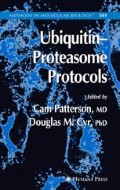Summary
Several important signaling processes depend on the tagging of cellular proteins with “polyubiquitin chains”—ubiquitin polymers whose building blocks are connected by isopeptide bonds between G76 of one ubiquitin and a specific lysine residue of the next one. Here we describe procedures for the synthesis of polyubiquitin chains of defined lengths that are linked through the K48 or K63 side chains. The method involves a series of enzymatic reactions in which proximally and distally blocked monoubiquitins (or chains) are conjugated to produce a particular chain in high yield. Individual chains are then deblocked and joined in another round of reaction. Successive rounds of deblocking and synthesis can give rise to a chain of any desired length.
Access this chapter
Tax calculation will be finalised at checkout
Purchases are for personal use only
References
Pickart, C. M. (2000) Ubiquitin in chains. Trends Biochem. Sci. 25, 544–548.
Peng, J., Schwartz, D., Elias, J. E., et al. (2003) A proteomics approach to understanding protein ubiquitination. Nat. Biotechnol. 21, 921–926.
Wilkinson, C. R. M., Seeger, M., Hartmann-Petersen, R., et al. (2001) Proteins containing the UBA domain are able to bind multi-ubiquitin chains. Nat. Cell Biol. 3, 939–943.
Raasi, S. and Pickart, C. M. (2003) Rad23 ubiquitin-associated domains (UBA) inhibit 26S proteasome-catalyzed proteolysis by sequestering lysine 48-linked polyubiquitin chains. J. Biol. Chem. 278, 8951–8959.
Buchberger, A. (2002) FroM UBA to UBX: new words in the ubiquitin vocabulary. Trends Cell Biol. 12, 216–221.
Varadan, R., Walker, O., Pickart, C. M., and Fushman, D. (2002) Structural properties of polyubiquitin chains in solution. J. Mol. Biol. 324, 637–647.
Varadan, R., Assfalg, M., Haririnia, A., Raasi, S., Pickart, C. M., and Fushman, D. (2004) Solution conformation of Lys63-linked di-ubiquitin chain provides clues to functional diversity of polyubiquitin signaling. J. Biol. Chem. 279, 10.1074/jbc.M309184200.
Piotrowski, J., Beal, R., Hoffman, L., Wilkinson, K. D., Cohen, R. E., and Pickart, C. M. (1997) Inhibition of the 26 S proteasome by polyubiquitin chains synthesized to have defined lengths. J. Biol. Chem. 272, 23712–23721.
Haldeman, M. T., Xia, G., Kasperek, E. M., and Pickart, C. M. (1997) Structure and function of ubiquitin conjugating enzyme E2-25K: the tail is a core-dependent activity element. Biochemistry 36, 10526–10537.
Hofmann, R. M. and Pickart, C. M. (1999) Noncanonical MMS2-encoded ubiquitin-conjugating enzyme functions in assembly of novel polyubiquitin chains for DNA repair. Cell 96, 645–653.
Hofmann, R. M. and Pickart, C. M. (2001) In vitro assembly and recognition of K63 polyubiquitin chains. J. Biol. Chem. 276, 27936–27943.
Johnston, S. C., Riddle, S. M., Cohen, R. E., and Hill, C. P. (1999) Structural basis for the specificity of ubiquitin C-terminal hydrolases. EMBO J. 18, 3877–3887.
Chen, Z., Niles, E. G., and Pickart, C. M. (1991) Isolation of a cDNA encoding a mammalian multi-ubiquitinating enzyme (E2-25K), and overexpression of the functional enzyme in E. coli. J. Biol. Chem. 266, 15698–15704.
Pickart, C. M., Kasperek, E. M., Beal, R., and Kim, A. (1994) Substrate properties of site-specific mutant ubiquitin protein (G76A) reveal unexpected features in the mechanism of ubiquitin activating enzyme (E1). J. Biol. Chem. 269, 7115–7123.
Acknowledgment
We thank R. Cohen for providing the YUH1 expression clone and for a critical reading of the manuscript.
Author information
Authors and Affiliations
Editor information
Editors and Affiliations
Rights and permissions
Copyright information
© 2005 Humana Press Inc.
About this protocol
Cite this protocol
Raasi, S., Pickart, C.M. (2005). Ubiquitin Chain Synthesis. In: Patterson, C., Cyr, D.M. (eds) Ubiquitin-Proteasome Protocols. Methods in Molecular Biology™, vol 301. Humana Press. https://doi.org/10.1385/1-59259-895-1:047
Download citation
DOI: https://doi.org/10.1385/1-59259-895-1:047
Publisher Name: Humana Press
Print ISBN: 978-1-58829-252-0
Online ISBN: 978-1-59259-895-3
eBook Packages: Springer Protocols

